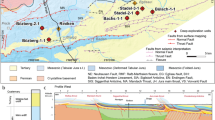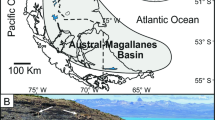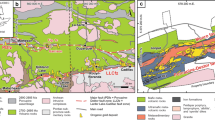Abstract
Beef structures (bedding-parallel veins of fibrous calcite) are widespread within the Lower Triassic carbonate rocks in the Sichuan Basin of China, especially within clay-rich strata of low permeability. In the veins, fibrous calcite occurs in the outer zones, and coarse equant calcite in the inner zones. At least two generations of calcite crystallization took place during aqueous alteration, at the same time as deformation recorded by the calcite. The first-generation calcite fibers are at steep angles to the hydrocarbon-bearing host beds, and they grew vertically against the force of gravity at a time when the source rocks were maturing. Second-generation calcite occurs as coarse equant grains that sealed pores via localized fluid flow during horizontal tectonic compression, so that shear stresses acted at the fracture margins. Shearing of the host rock was accommodated in part by dissolution-precipitation creep (DPC), grain rotation, and grain slippage, recorded in crystallographic preferred orientations (CPOs) of the host calcite grains beside the crack walls. The beef veins formed during high pore-fluid overpressures along hydrofractures. We propose that the bedding-parallel veins with beef structures are evidence of a “crack-seal slip” fault valve process during hydrocarbon generation. The hydrocarbon-bearing calcite beef structure may be a good indicator of oil or gas migration, and of the flow direction of aqueous solutions.
Similar content being viewed by others
References
Barbosa P F, Lagoeiro L. 2012. Sheared-bedding parallel quartz vein as an indicator of deformation processes. Tectonophysics, 564–565: 101–113
Barnhoorn A, Bystricky M, Burlin L, et al. 2005. Post-deformational annealing of calcite rocks. Tectonophysics, 403: 167–191
Becker A. 1995. Quartz pressure solution: Influence of crystallographic orientation. J Struct Geol, 17: 1395–1397, 1399–1405
Bestmann M, Prior D J. 2003. Intragranular dynamic recrystallization in naturally deformed calcite marble: Diffusion accommodated grain boundary sliding as a result of subgrain rotation recrystallization. J Struct Geol, 25: 1597–1613
Bestmann M, Prior D J, Grasemann B. 2006. Characterisation of deformation and flow mechanics around porphyroclasts in a calcite marble ultramylonite by means of EBSD analysis. Tectonophysics, 413: 185–200
Bons P D, Den Brok B. 2000. Crystallographic preferred orientation development by dissolution-precipitation creep. J Struct Geol, 22: 1713–1722
Bons P D, Elburg M A, Gomez-Rívas E. 2012. A review of the formation of tectonic veins and their microstructures. J Struct Geol, 43: 33–62
Boullier A M, Robert F. 1992. Paleoseismic events recorded in Archean gold-quartz vein networks, Val d’Or, Abitibi, Quebec. J Struct Geol, 14: 161–179
Bradshaw R, Phillips F C. 1967. X-ray studies of natural fabrics. I. Growth-fabrics in hematite kidney ore and in fibrous calcite. Mineral Mag, 36: 70–77
Buckland R W, De La Beche H T. 1835. On the geology of the neighbourhood of Weymouth and the adjacent parts of the coast of Dorset. T Geol Soc Lond, 4: 1–46
Burkhard M, Knipe R J, Rutter E H. 1990. Ductile deformation mechanisms in micriticlimestones naturally deformed at low temperatures (150–350°C). Geol Soc Lond Spec Publ, 54: 241–257
Casey M, Kunze K, Olgaard D L. 1998. Texture of Solnhofen limestone deformed to high strains in torsion. J Struct Geol, 20: 255–267
Cobbold P R, Rodrigues N. 2007. Seepage forces, important factors in the formation of horizontal hydraulic fractures and bedding-parallel fibrous veins (“beef” and “cone-in-cone”). Geofluids, 7: 313–322
Cobbold P R, Zanella A, Rodrigues N, et al. 2013. Bedding-parallel fibrous veins (beef and cone-in-cone): Worldwide occurrence and possible significance in terms of fluid overpressure, hydrocarbon generation and mineralization. Mar Petrol Geol, 43: 1–20
Cosgrove J W. 2001. Hydraulic fracturing during the formation and deformation of a basin: A factor in the dewatering of low-permeability sediments. Am Assoc Pet Geol Bull, 85: 737–748
Davison I. 1995. Fault slip evolution determined from crack-seal veins in pull-aparts and their implications for general slip models. J Struct Geol, 17: 1025–1034
Dietrich D, McKenzie J A, Song H L. 1983. Origin of calcite in syntectonic veins as determined from carbon-isotope ratios. Geology, 11: 547–551
Durney D W, Ramsay J G. 1973. Incremental strains measured by syntectonic crystal growths. In: De Jong K A, Scholten R, eds. Gravity and Tectonics. New York: Wiley-Interscience. 67–96
Fischer M P, Higuera-Díaz I C, Evans M A, et al. 2009. Fracture-controlled paleohydrology in a map-scale detachment fold: Insights from the analysis of fluid inclusions in calcite and quartz veins. J Struct Geol, 31: 1490–1510
Groshong R H. 1988. Low temperature deformation mechanisms and their interpretation. Bull Geol Soc Am, 100: 1329–1360
Guan S W, He D F, Lei Y L, et al. 2013. Kinematic classification, structural modeling and prospective fields of the foreland thrust belts in Midwest China. Petrol Explor Dev, 40: 66–78
Gustavson T C, Hovorka S D, Dutton A R. 1994. Origin of satin spar veins in evaporite basins. J Sediment Res, 64: 88–94
Halferdal L B. 1960. Gypsum deposit at Peace Point, northern Alberta. Alberta Res Coun Internal Report. 12
Heidelbach F, Post A, Tullis J. 2000. Crystallographic preferred orientation in albite samples deformed experimentally by dislocation and solution precipitation creep. J Struct Geol, 22: 1649–1661
Knipe R J. 1989. Deformation mechanisms-recognition from natural tectonites. J Struct Geol, 11: 127–146
Lacombe O. 2007. Comparison of paleostress magnitudes from calcite twins with contemporary stress magnitudes and frictional sliding criteria in the continental crust: Mechanical implications. J Struct Geol, 29: 86–99
Lash G G, Engelder T. 2005. An analysis of horizontal microcracking during catagenesis: Example from the Catskill delta complex. Am Assoc Pet Geol Bull, 89: 1433–1449
Lister G S, Williams P F. 1983. The partitioning of deformation in flowing rock masses. Tectonophysics, 92: 1–33
Liu S G, Deng B, Li Z W, et al. 2012. Architecture of basin-mountain systems and their influences on gas distribution: A case study from the Sichuan basin, South China. J Asian Earth Sci, 47: 204–215
Lu Z Y, Zhao L Z, Li T. 2004. Study on hydrocarbon sources of Lower Triassic Jialingjiang Formation in south of Sichuan Basin, China (in Chinese). J Chengdu Univ Tech (Sci Tech), 31: 720–722
McCaffrey K J W, Lonergan L, Wilkinson J J. 2000. Fractures, fluid flow and mineralization. Geol Soc Lond Spec Publ, 81: 215
Means W D, Li T. 2001. A laboratory simulation of fibrous veins: Some first observations. J Struct Geol, 23: 857–863
Meng Q R, Wang E Q, Hu J M. 2005. Mesozoic sedimentary evolution of the northwest Sichuan Basin: Implication for continued clockwise rotation of the South China block. Geol Soc Am Bull, 117: 396–410
Molli G, White J C, Kennedy L, et al. 2011. Low-temperature deformation of limestone, IsolaPalmaria, northern Apennine, Italy—The role of primary textures, precursory veins and intracrystalline deformation in localization. J Struct Geol, 33: 255–270
Osborne M J, Swarbrick R E. 1997. Mechanisms for generating overpressure in sedimentary basins: A reevaluation. Am Assoc Pet Geol Bull, 81: 1023–1041
Passchier C W, Trouw R A J. 2005. Microtectonics. 2nd ed. Heidelberg: Springer. 26–66
Peacock D C P, Sanderson D J. 1991. Displacements, segment linkage and relay ramps in normal fault zones. J Struct Geol, 13: 721–733
Peacock D C P, Sanderson D J. 1995. Pull-aparts shear fractures and pressure solution. Tectonophysics, 241: 1–13
Petit J P, Wibberley C A J, Ruiz G. 1999. “Crack-seal”, slip: A new fault valve mechanism? J Struct Geol, 21: 1199–1207
Phillips O M. 1972. Turbulence in a strongly stratified fluid—Is it unstable? Deep Sea Res Oceanogr Abstr, 19: 79–81
Ramsay J. 1980. The crack-seal mechanism of rock deformation. Nature, 284: 135–139
Rodrigues N, Cobbold P R, Løseth H, Ruffet G. 2009. Widespread bedding-parallel veins of fibrous calcite (“beef”) in a mature source rock (VacaMuertaFm, Neuquén Basin, Argentina): Evidence for overpressure and horizontal compression. J Geol Soc, 166: 695–709
Rutter E H. 1999. On the relationship between the formation of shear zones and the form of the flow law for rocks undergoing dynamic recrystallization. Tectonophysics, 303: 147–158
Schenk O, Urai J L, Evans B. 2005. The effect of water on recrystallization behavior and grain boundary morphology in calcite-observations of natural marble mylonites. J Struct Geol, 27: 1856–1872
Sibson R H. 2003. Brittle-failure controls on maximum sustainable overpressure in different tectonic regimes. Am Assoc Pet Geol Bull, 87: 901–908
Sibson R H, Robert F, Poulsen K H. 1988. High-angle reverse faults, fluid-pressure cycling, and mesothermal gold-quartz deposits. Geology, 16: 551–555
Singhal B B S, Gupta R P. 2010. Applied Hydrogeology of Fractured Rocks. Heidelberg: Springer. 293–363
Stallard A, Shelley D. 1995. Quartz c-axes parallel to stretching directions in very low-grade metamorphic rocks. Tectonophysics, 249: 31–40
Stoneley R. 1983. Fibrous calcite veins, overpressures, and primary oil migration. Am Assoc Pet Geol Bull, 67: 1427–1428
Suchy V, Dobes P, Filip J, et al. 2002. Conditions for veining in the Barrandian Basin (Lower Palaeozoic), Czech Republic: Evidence from fluid inclusion and apatite fission track analysis. Tectonophysics, 348: 25–50
Swarbrick R E, Osborne M J, Yardley G S. 2002. Comparison of overpressure magnitude resulting from the main generating mechanisms. In: Huffman A R, Bowers G L, ed. Pressure Regimes in Sedimentary Basins and Their Prediction. Am Assoc Pet Geol Memoir, 76: 1–12
Tang J H, Zhang T W, Bao Z Y, et al. 2004. Study of organic inclusions in the carbonate reservoir bed of the Weiyuan gas field in the Sichuan Basin. Geol Rev, 50: 210–214
Tapponnier P, Lacassin R, Leloup P H, et al. 1990. The Ailao Shan/Red River metamorphic belt: Tertiary left-lateral shear between Indochina and South China. Nature, 343: 431–437
Wenk H R, Takeshita T, Bechler E, et al. 1987. Pure shear and simple shear calcite textures. Comparison of experimental, theoretical and natural data. J Struct Geol, 9: 731–745
Xu X, Wen X, Yu G. 2009. Coseismic reverse-and oblique-slip surface faulting generated by the 2008 Mw 7.9 Wenchuan earthquake, China. Geology, 37: 515–518
Zanella A, Cobbold P R. 2012. “Beef”: Evidence for fluid overpressure and hydraulic fracturing in source rocks during hydrocarbon generation and tectonic events: Field studies and physical modelling. In: Geofluids VII International Conference, Rueil-Malmasion
Zhang B, Yan S Y, Gu Z D, et al. 2013. SEM/EBSD analysis of quartz cementation and compaction microstructures during diagenesis of sandstone. Sci China Earth Sci, 56: 1281–1293
Zhang B, Zhang J J, Zhong D L, et al. 2012. Polystage deformation of the Gaoligong metamorphic zone: Structures, 40Ar/39Ar mica ages, and tectonic implications. J Struct Geol, 37: 1–18
Author information
Authors and Affiliations
Corresponding author
Rights and permissions
About this article
Cite this article
Zhang, B., Yin, C., Gu, Z. et al. New indicators from bedding-parallel beef veins for the fault valve mechanism. Sci. China Earth Sci. 58, 1320–1336 (2015). https://doi.org/10.1007/s11430-015-5086-6
Received:
Accepted:
Published:
Issue Date:
DOI: https://doi.org/10.1007/s11430-015-5086-6




